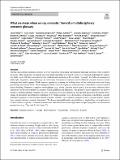What we mean when we say semantic: Toward a multidisciplinary semantic glossary
Author(s)
Reilly, Jamie; Shain, Cory; Borghesani, Valentina; Kuhnke, Philipp; Vigliocco, Gabriella; Peelle, Jonathan E.; Mahon, Bradford Z.; Buxbaum, Laurel J.; Majid, Asifa; Brysbaert, Marc; Borghi, Anna M.; De Deyne, Simon; Dove, Guy; Papeo, Liuba; ... Show more Show less
Download13423_2024_Article_2556.pdf (1.543Mb)
Publisher with Creative Commons License
Publisher with Creative Commons License
Creative Commons Attribution
Terms of use
Metadata
Show full item recordAbstract
Tulving characterized semantic memory as a vast repository of meaning that underlies language and many other cognitive processes. This perspective on lexical and conceptual knowledge galvanized a new era of research undertaken by numerous fields, each with their own idiosyncratic methods and terminology. For example, “concept” has different meanings in philosophy, linguistics, and psychology. As such, many fundamental constructs used to delineate semantic theories remain underspecified and/or opaque. Weak construct specificity is among the leading causes of the replication crisis now facing psychology and related fields. Term ambiguity hinders cross-disciplinary communication, falsifiability, and incremental theory-building. Numerous cognitive subdisciplines (e.g., vision, affective neuroscience) have recently addressed these limitations via the development of consensus-based guidelines and definitions. The project to follow represents our effort to produce a multidisciplinary semantic glossary consisting of succinct definitions, background, principled dissenting views, ratings of agreement, and subjective confidence for 17 target constructs (e.g., abstractness, abstraction, concreteness, concept, embodied cognition, event semantics, lexical-semantic, modality, representation, semantic control, semantic feature, simulation, semantic distance, semantic dimension). We discuss potential benefits and pitfalls (e.g., implicit bias, prescriptiveness) of these efforts to specify a common nomenclature that other researchers might index in specifying their own theoretical perspectives (e.g., They said X, but I mean Y).
Date issued
2024-09-04Department
McGovern Institute for Brain Research at MIT; Massachusetts Institute of Technology. Department of Brain and Cognitive SciencesJournal
Psychonomic Bulletin & Review
Publisher
Springer US
Citation
Reilly, J., Shain, C., Borghesani, V. et al. What we mean when we say semantic: Toward a multidisciplinary semantic glossary. Psychon Bull Rev (2024).
Version: Final published version